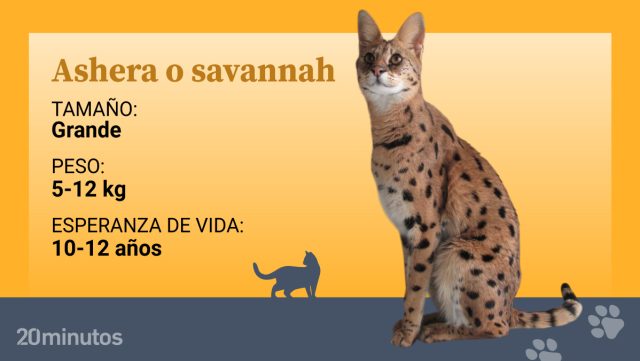When the desire for exclusivity and animalstrends arise that, although visually attractive and colorful, carry worrying consequences. One of them is the growing fascination with gatos that seem to have left directly from the jungle, the result of the cross between domestic and wild species.
Just a few days ago, the Civil guardian stopped in Manacor (Mallorca) to a couple accused of raising and illegally sell exotic felinesincluding a desert lynx and two servals, in addition to marketing internationally with other protected species such as white tigers, melanic leopards, hyenas and pumas.
With their mottled furs and striking sizes, the cats of the Bengalí or Savannah race have gained popularity in social networks and sale platforms. However, international organizations of reference in feline medicine, such as International Cat Carey The Cat Groupthey have raised their voice unanimously: They do not support the breeding or possession of hybrid cats as pets. Their arguments do not focus on aesthetic or fashionable issues, but on the deep ethical, health and behavioral problems that surround these animals.
What is a hybrid cat?
Hybrid cats are the result of crossing a domestic cat with a kind of wild feline. These mixtures usually attract due to their exotic appearance and their athletic and powerful physique, but Wild heritage is not limited to the outside And many of these animals retain behaviors of their ancestors, which hinders their adaptation to domestic life.
Difficult needs to meet
One of the main reasons why feline organizations advise against their possession is the difficulty of covering their physical and emotional needs. Being animals with strong wild genetic load, they can present more aggressive and territorial behaviorsthat do not always fit together in a home.
In addition, their interior confinement, necessary to protect local fauna and avoid leaks, usually cause them frustration, anxiety and behavioral problems. The lack of specific studies on the well -being of these cats makes it even more difficult to guarantee a good quality of life.
Hybrid breeding: risks for all those involved
The hybrid cat breeding process also raises serious concerns. In many cases, wild felines are used such as servals (which can weigh 15 kilos) to cross them with domestic cats, which generates physical and genetic incompatibilities.
Gestation is usually full of complications: abortions, premature births, unfeasible offspring or long -term health problems. In addition, the difference in size between parental species also implies a real risk for domestic cat during mating or childbirth.
As if that were not enough, the illegal traffic of wild animals To supply the hybrid market it is still a constant concern. Some specimens are introduced in the destination countries clandestinely, which increases the health and ethical risks of the process.
Abandonment and lack of veterinary attention
The difficulty in managing these animals has caused an increase in cases of abandonment or deliveries to shelters, which do not always have the resources to properly take care of them. Not behaving like a typical domestic cat, these hybrids require specialized attention, environmental enrichment and adapted diet that, in many cases, do not receive.
Even Among the most committed holders, veterinary care is not always adequatethey alert from Icatcare, since many veterinarians are not familiar with the specific needs of hybrids, and visits can be complicated by the animal’s behavior. To this is added the difficulty of knowing the true generation to which each specimen belongs (F1, F2, F3 …), since there are no reliable genetic tests to determine it.
The rise of these cats responds, in part, to the desire to possess something unique, striking and unusual, but when it comes to living beings, visual attraction cannot be above well -being. Specialized organizations insist: the crossing between wild and domestic cats is not only an aesthetic issue, but a real health, safety and responsibility problem.
Although some hybrids of distant generations, such as fifth or sixth generation beans, already present behaviors closer to the domestic cat, most experts agree that there are Many feline races adapted to family life that offer beauty, character and balance without resorting to hybridization.








